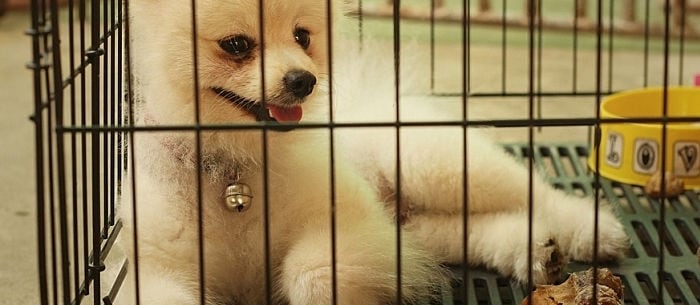Getting your new puppy or dog on a crate training schedule can help them adjust to their new surroundings and will give them a head start on learning the house rules right out of the gate. Using a crate helps limit unwanted behavior, such as a dog who starts to rip apart furniture because of separation anxiety or if you have a dog who eats everything they can get their mouth on. Crate training can also help you to house-train a new puppy so they’ll understand where they can go and — more importantly — where they can’t go to the bathroom.
The benefit of crate training, according to veterinarian Dr. Melissa Webster, the owner of Tampa Veterinary Hospital in Tampa, Florida, “is that when you’re starting with a puppy, you can control destructive behavior. But don’t just put a dog in the crate and walk out of the house. Use positive reinforcement with treats and encourage him with his favorite toy.”
Webster also stresses making sure to get the right-sized crate. Many people mistakenly purchase a crate that’s too small for their dog, she notes. Use a crate that allows the dog to stand up and stretch out without pressing up against the sides or top.
 Dog crate training tips
Dog crate training tips

Feed all meals and treats inside the crate
Encourage your dog to want to go into the crate by feeding all of their treats and meals inside it. When your dog stands outside the crate, simply toss in a handful of dry food. They will automatically climb into the crate to eat the food.
Create a verbal cue
Now that your dog enjoys the crate, select a word that will help your dog identify when to go into the crate. For example, if you select the word “crate,” put in the treat and call “crate” as your dog steps in. Once your dog is inside, give them the treat.
Make a crate training schedule
Decide how and when you want to use the crate and devise a training schedule. For example, if you’re housebreaking a puppy, your pup will stay in the crate until you let them out to use the bathroom. According to the American Kennel Club (AKC), the best way to housebreak a puppy is to get them on a schedule right away.
Puppy crate training schedule samples
How often you use the crate will depend on your lifestyle. For example, a weekday crate scheduling might revolve around your work or school hours, while the weekend schedule could offer more flexibility. If you have a full-time job that takes you away from the home throughout the day, attempting to crate train a smaller puppy that requires more frequent potty breaks may present a challenge. However, you can still work on crate training a puppy on weekends when you can spend more time at home.
Here are examples of weekday and weekend training schedules that you can adjust to suit your lifestyle:
Sample weekday crate training schedule
- 12 to 16 weeks of age. Crate your dog for two hours during the day and six hours during the night.
- 4 to 5 months of age. Crate your dog for three hours during the day and eight hours during the night.
- 6 to 7 months of age. Crate your dog for four hours during the day and eight hours during the night.
- 8 to 11 months of age. Crate your dog for six hours during the day and eight hours during the night.
- Over 12 months of age. Crate your dog for eight hours during the day and 10 hours during the night.
Read more:
Sample weekend crate training schedule
- Friday. On Fridays when you’re home, leave the crate door open. Toss treats into the crate randomly, and if your dog happens to go near the crate on his own, reward them. You should also feed your dog their dinner inside of the crate.
- Saturday. Start using verbal cues with your dog on Saturday, beginning with a practice exercise where you will say the cue, such as “crate,” and then toss in a treat. Repeat the exercise about 10 times and then take a break. Throughout the day and evening, repeat this exercise at least three times.
- Sunday. On Sunday your dog will begin to learn how to stay in the crate for longer periods of time. Starting in the morning, give your dog the usual cue to get them to go into the crate, then leave them in the crate for at least 30 minutes. Make sure to put in a chew toy or bone so that they has something to occupy him. After the 30 minutes has passed, let them out of the crate but don’t reward them with any treats.
Once your dog gets used to being on a crate training schedule, they will not only get in the crate when you leave the house or serve dinner, they will actually get excited to use it.



